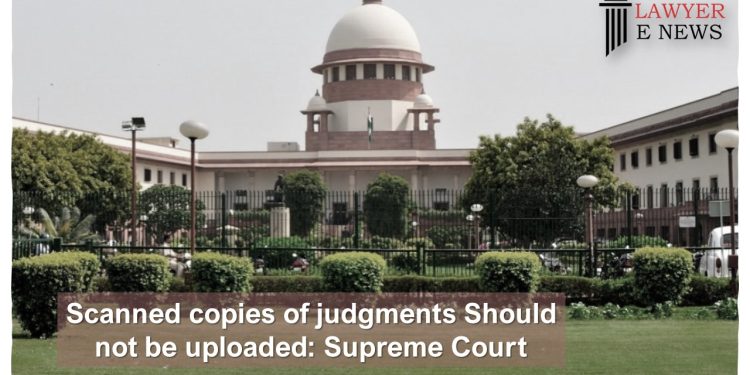Scanned copies of judgments Should not be uploaded: Supreme Court

The Supreme Court has instructed courts and tribunals to refrain from posting scanned copies of printed decisions (State Bank of India and anr v. Ajay Kumar Sood) on their websites.
Judicial institutions should make sure that decision copies uploaded are available and signed using digital signatures, according to a bench of Justices DY Chandrachud and AS Bopanna.
“The version of the decisions and orders that have been published must also be accessible and digitally signed, according to courts and tribunals. They must not be scanned copies of printed materials “said the Court.
The Court further stated that printing and scanning papers is a pointless, time-consuming operation that accomplishes nothing.
The court’s ruling stated that the practise “should be eliminated from the litigation process as it tends to render papers as well as the procedure inaccessible for a wide range of individuals.”
A challenge to a 2020 Himachal Pradesh High Court decision that affirmed a 2019 Central Government Industrial Tribunal (CGIT) verdict was being heard by the Supreme Court.
The respondent’s disciplinary punishment had been changed by the CGIT from termination to mandatory retirement.
The Bench had given notice in the case in March 2021 after ruling that the evidence in the CGIT order supported the existence of a severe act of misconduct.
However, the top court had mandated that no coercive action be done against the respondent until the appeal’s final disposition because it found the 18-page High Court decision upholding the CGIT order to be incomprehensible.
The supreme court continued by stating that judgements written in such difficult-to-understand language do a disservice to the goal of providing citizens with accessible and understanding justice.
The case was then heard, and on August 16 of this year, a definitive judgement was given, remanding the matter to the High Court for new consideration.
The Court claimed that it was forced to do so because it had no other choice.
The High Court must recognise the delay and expense occasioned as a result and must make an effort to record reasons which are understood by all stake-holders, the bench reasoned. “If the meaning of the written word is lost in language, the ability of the adjudicator to retain the trust of the reader is severely eroded.”
The Court stated that a litigant would have a harder time understanding such directives than the court did.
“The litigant, who is untrained in the law, is presented with language that is not heard, written, or spoken in modern form. The goal of judicial writing is defeated by language like that in a ruling. The effectiveness of the legal system is diminished by the type of judgement writing that is being appealed to us. Behind the façade of complicated language, judicial writing does not aim to perplex or confound the reader. The judge must write to provide an understandable understanding of the legal and factual issues that need to be decided “declared the supreme court.
The Court emphasised that judgments of the higher judiciary serve as precedents to direct subsequent benches and that they must make sense to individuals whose lives and affairs are affected by their conclusion.
The justices noted that because of this, judicial processes are founded on the confidence that writing inspires. The highest court further stated that a judge’s work cannot be boiled down to a statistic on the outcome of a case.
“Courts are actively involved in the gradual but noticeable process of bringing about societal change. Both the strength of the arguments and the design of the judicial procedure serve to measure how successful or unsuccessful they are in that goal.”
State Bank of India and Another
Vs
Ajay Kumar Sood






